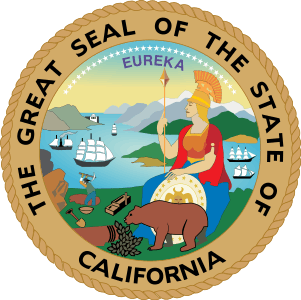Territorial evolution of California
The following timeline traces the territorial evolution of California, the thirty-first state admitted to the United States of America, including the process of removing Indigenous Peoples from their native lands, or restricting them to reservations.
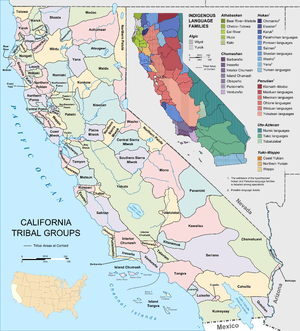
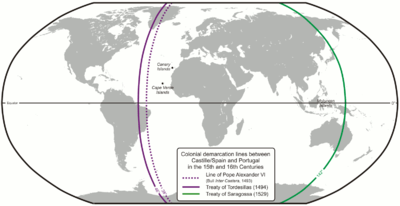
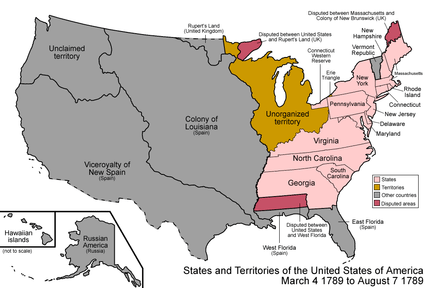
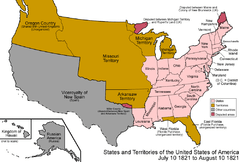
.svg.png)
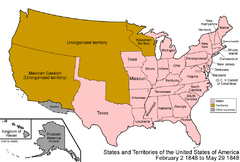
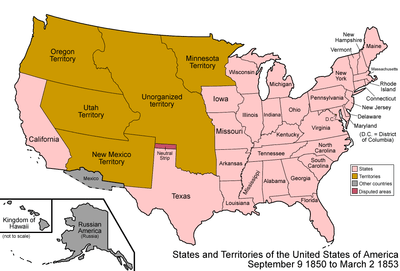
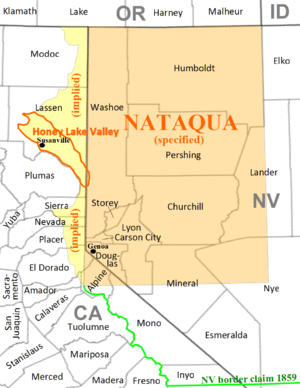
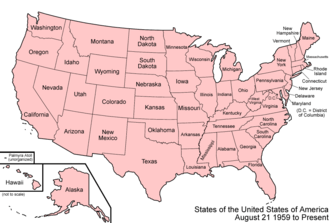
Timeline
Indigenous & territorial claims prior to 1768
- Indigenous peoples of California
- Early European edicts and claims that included the yet unknown land of California
- Inter caetera papal bull issued by Pope Alexander VI, 1493
- Treaty of Tordesillas, 1494
- Vasco Núñez de Balboa claims South Sea (Pacific Ocean) and all adjoining lands for Spain, 1513
- Treaty of Saragossa, 1529
- Early European claims on California soil
- San Miguel (San Diego) claim made by Juan Rodríguez Cabrillo on behalf of Spain, 1542
- New Albion ( Point Reyes) claim made by Sir Francis Drake on behalf of England, 1579
Spanish period (1768-1821)
- Las Californias claimed by Spain under the governance of the Viceroyalty of New Spain, 1768–1804
- Spanish missions in California, 1769-1833
- Relocation of Mission Indians, 1769-1834
- Spanish rancho land grants, 1769-1821
- Spanish missions in California, 1769-1833
- Alta California Province established, 1804–1821
- Fort Ross established by Russia (the Russian-American Company), 1812-1842
- Adams-Onis Treaty of 1819
- Mexican War of Independence, 1808-1821
- Treaty of Córdoba of 1821
Mexican period (1821-1848)
- Alta California Province administered by Mexico after Treaty of Córdoba, 1821-1824
- Mexican rancho land grants, 1821-1846
- First Mexican Empire, 1821-1823
- Provisional Government of Mexico, 1823-1824
- First Mexican Republic, 1824-1835
- Alta California Territory established via the 1824 Constitution of Mexico, 1824–1836
- Treaty of Limits (Mexico–United States), 1828
- Mexican secularization act of 1833
- Centralist Republic of Mexico, 1835-1846
- California's Lone Star coup and declaration of independence, 1836
- Las Californias Department established by Las Siete Leyes (The Seven Laws), 1836-1846
- Second Federal Republic of Mexico, 1846-1848
- Alta California Territory reestablished when 1824 Constitution of Mexico was restored, 1846-1848
- Mexican–American War, 1846–1848
- California Republic (25 days), 1846
- U.S. military government of California, 1846–1849
- Treaty of Cahuenga, 1847
- Treaty of Guadalupe Hidalgo of 1848
- Mexican Cession of 1848
American period (1848-present)
- Alta California administered by the United States as part of the Mexican Cession Unorganized territory, 1848-1850
- Provisional government of California, 1849–1850
- State of Deseret (extralegal), 1849–1850
- Constitution of California (see California Constitutional Boundaries), October 13, 1849
- Compromise of 1850
- State of California since 1850
- California Statehood Act, September 9, 1850[1]
- Act for the Government and Protection of Indians, April 22, 1850
- California Indian Wars, 1850-1880
- Aboriginal title in California, 1851-present
- California Land Act of 1851
- California Indian Reservations and Cessions, 1851-1892
- California Rancheria Termination Acts, 1956-present
- California-Nevada border disputes, 1856-1980[2]
- Nataqua Territory, 1856-1861
- Roop County dispute, 1861-1864
- California-Oregon border dispute, 1868-present
California Constitutional Boundaries
CONSTITUTION OF THE STATE OF CALIFORNIA (1849)
Article XII; Boundary
The Boundary of the State of California shall be as follows:
Commencing at this point of intersection of 42d degree of north latitude with the 120th degree of longitude west from Greenwich, and running south on the line of said 120th degree of west longitude until it intersects the 39th degree of north latitude; thence running in a straight line in a south easterly direction to the River Colorado, at a point where it intersects the 35th degree of north latitude; thence down the middle of the channel of said river, to the boundary line between the United States and Mexico, as established by the Treaty of May 30th, 1848; thence running west and along said boundary line to the Pacific Ocean, and extending therein three English miles; thence running in a northwesterly direction, and following the direction of the Pacific Coast to the 42d degree of north latitude, thence on the line of said 42d degree of north latitude to the place of beginning. Also all the islands, harbors, and bays, along adjacent to the Pacific Coast.
See also
- History of California
- Historical outline of California
- California Genocide
- An Act for the Admission of the State of California
- Partition and secession in California
- Territorial evolution of North America since 1763
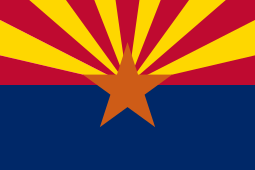
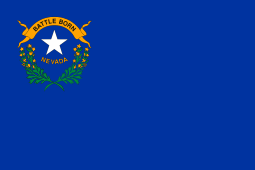
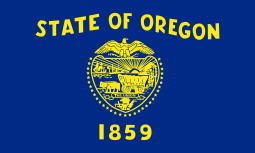
References
- Thirty-first United States Congress (September 9, 1850). "An Act for the Admission of the State of California into the Union" (cgi-bin). Retrieved June 5, 2009.
- "State of CALIFORNIA, Plaintiff, v. State of NEVADA". Legal Information Institute. Cornell Law School. Retrieved 1 August 2020.
